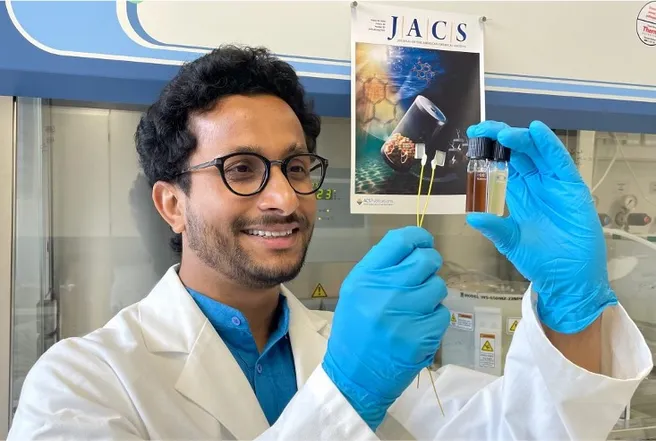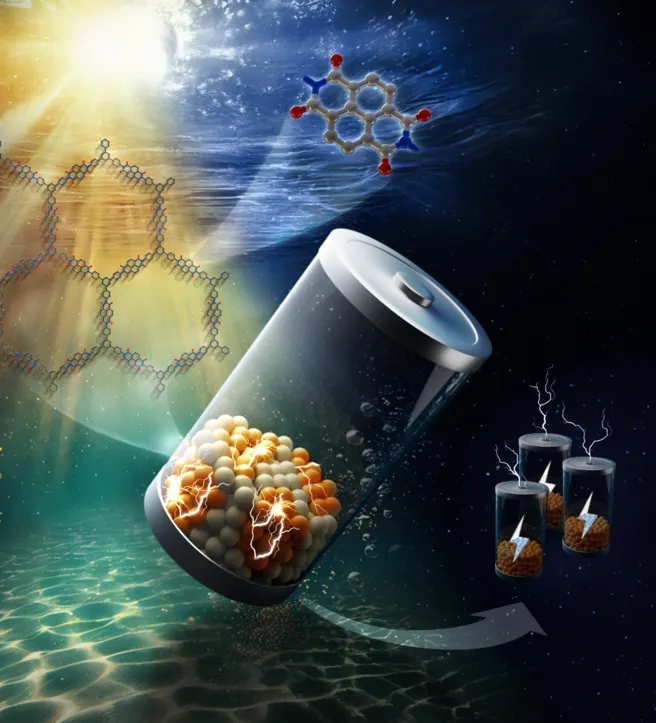This material acts like a solar reservoir – storing energy and releasing it as electricity long after sunset. The captured solar energy can thus also be used to supply electricity in the dark. For the first time, it has been possible to combine solar harvesting and long-term energy storage in a single, metal-free molecular framework – effectively merging the functions of a solar cell and a battery into a single, lightweight, and sustainable system.
Researchers at the Technical University of Munich (TUM), the Max Planck Institute for Solid State Research in Stuttgart, and the University of Stuttgart, with support from the Cluster of Excellence e-conversion, have developed a highly porous, two-dimensional covalent organic framework (COF) based on naphthalenediimide. This framework not only absorbs sunlight but also stabilizes the resulting photo-induced charges, enabling energy storage for more than 48 hours in aqueous environments.
The stored charges are not merely retained but can be actively discharged to power an external load, enabling real energetic use. “This material has dual functionality and acts as both a solar absorber and a long-term charge reservoir,” said Dr. Bibhuti Bhusan Rath, lead author of the study and postdoc in the research team of Prof. Bettina Lotsch (director at the Max Planck Institute for Solid State Research). “Its performance exceeds that of many existing optoionic materials – and it does so without relying on metals or rare elements.”
By combining advanced optical, electrochemical, and computational techniques, the researchers discovered that water plays a central role in stabilizing the stored charges. Rather than interacting strongly with external ions, water molecules respond to the charges in the COF backbone in a way that creates an energetic barrier, effectively preventing recombination of the light-generated trapped charges and preserving the energy for later release. The material exhibits a charge storage capacity of 38 mAh/g, outperforming similar frameworks and other light-responsive materials such as carbon nitrides and metal–organic frameworks.
Simplicity and robustness
The theoretical mechanism behind this behavior was elucidated together with the team of Frank Ortmann, Professor of Theoretical Methods in Spectroscopy at the TUM School of Natural Sciences, the second corresponding author of the study. Through extensive simulations, they evaluated various charge stabilization scenarios. They collaborated closely with the experimental team to understand the interplay between the COF structure, electronic states, and the surrounding water environment. “The beauty of this system lies in its simplicity and robustness,” said Ortmann. “It stores light-induced charges in a stable state, resulting from the unique interplay of molecular design, framework architecture, and environment, and releases them as needed.”
The team, which collaborated with researchers from the group of Prof. Joris van Slageren from the University of Stuttgart, further demonstrated excellent cycling stability, with over 90% capacity retention after multiple charging cycles, pointing to a powerful new platform for solar batteries. “This work highlights the potential of organic frameworks to be fine-tuned for advanced energy applications — using only organic building blocks and water,” said principal author Lotsch. “It marks a significant step toward sustainable, materials-driven energy storage solutions and off-grid applications.”
The innovative approach to solar batteries is being further researched at the recently founded MPG-TUM Solar Battery Center (SolBat).
Publication
Bibhuti Bhusan Rath, Laura Fuchs, Friedrich Stemmler, Andrés Rodríguez-Camargo, Yang Wang, Maximilian F. X. Dorfner, Johann Olbrich, Joris van Slageren, Frank Ortmann, Bettina V. Lotsch: Insights into Decoupled Solar Energy Conversion and Charge Storage in a 2D Covalent Organic Framework for Solar Battery Function, published in Journal of the American Chemical Society, April 28, 2025, https://pubs.acs.org/doi/10.1021/jacs.4c17642
Further information and links
This work was supported by the Max Planck Society, the Max Planck Foundation (Project SolBat), the German Research Foundation (DFG) via the CRC 1333 and the Cluster of Excellence e-conversion. Additional support came from the Alexander von Humboldt Foundation and computing resources at TU Dresden and LRZ Garching.
Contacts for this article:
Dr. Bibhuti Bhusan Rath
Max Planck Institute for Solid State Research
bb.rath@fkf.mpg.de
Prof. Dr. Frank Ortmann
Technical University of Munich
TUM School of Natural Sciences
Professor for Theoretical Methods in Spectroscopy
frank.ortmann@tum.de
Prof. Dr. Bettina V. Lotsch
Max Planck Institute & LMU Munich
b.lotsch@fkf.mpg.de
Technical University of Munich
Corporate Communications Center
- Caroline Zörlein and Ulrich Meyer
- presse@tum.de
- Teamwebsite

